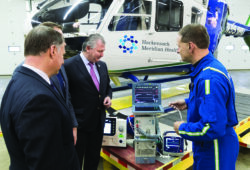Best Practices in Disinfection Processes to Prevent Duodenoscope Infection Transmission
Multiple outbreaks of a drug-resistant infection linked to contaminated duodenoscopes have prompted nationwide re-evaluation of sterilization procedures and an ongoing discussion about the scopes’ design and ultimate safety.
Concerns about duodenoscope contamination arose after seven patients developed infections and two died between October 2014 and January 2015 at UCLA’s Ronald Reagan Medical Center. The infections were caused by the drug-resistant bacteria carbapenem-resistant Enterobacteriaceae (CRE). Earlier this year, Virginia Mason Medical Center in Seattle, Washington, also reported 32 patients developed such infections and 11 of them died.
Outbreaks related to contaminated duodenoscopes previously occurred in 2012 at the University of Pittsburgh Medical Center and in 2013 at Advocate Lutheran General Hospital in Park Ridge, Illinois. In late 2014, duodenoscopes were linked to 281 patient infections at Hartford Hospital in Connecticut.
FDA Clarifies Guidelines
Duodenoscopes are used in approximately 500,000 procedures a year to examine and sometimes treat conditions of the duodenum such as blockage of the bile duct or bleeding in the upper gastrointestinal tract, according to the U.S. Food and Drug Administration (FDA).
Duodenoscopes are flexible, lighted tubes threaded through the mouth, throat and stomach into the top of the small intestine, or duodenum. The end of the tube is outfitted with a tiny light, camera and air nozzle, as well as a movable “elevator” mechanism that opens and closes to allow the operator to use various miniature tools.
These elements are packed into a space about as big as the end of a man’s little finger, notes Rusty Holman, M.D., chief medical officer for LifePoint Health. This makes them challenging to thoroughly sterilize.
In March, the FDA issued guidelines for cleaning and sterilizing duodenoscopes that in some instances exceed recommendations of their manufacturers Olympus, Pentax and Fujifilm.
In a statement, the FDA said it is working with the manufacturers to assess potential design changes and determine whether new disinfection processes can ensure the scopes’ safety in their current configuration.
Ensuring duodenoscope safety “is on the agency’s priority list for guidance documents we intend to publish in 2015,” the FDA statement says.
Best Practices
The Source asked infection control experts at member healthcare organizations HCA and LifePoint to explain the issue and outline best practices for protecting patient health.
The FDA cautions that duodenoscopes are complex instruments with many small working parts requiring thorough cleaning and disinfecting to prevent tissue or fluid from one patient remaining in a scope when it is used on a subsequent patient.
“In rare cases, this can lead to patient-to-patient infection,” even when the manufacturers’ instructions for cleaning and sterilization have been followed, says Edward Septimus, M.D., medical director of Infection Prevention and Epidemiology Clinical Services Group at HCA.
Both Holman and Septimus note that their organizations have added to federal and manufacturers’ guidelines, and they work with their respective hospitals to make sure the expanded guidelines are rigorously followed.
HCA and LifePoint have enterprise-wide infection prevention groups that regularly review and adjust guidelines. In line with the federal guidelines and their own policies, best practices to prevent infection include:
• Visual inspection of the scope, especially the elevator mechanism. This should be done “under a bright light and through a magnifying device after initial cleaning to make sure all debris has been removed,” Septimus says.
• “It’s also important to use a small-bristle brush to remove debris from the elevator channel,” he continues. “Debris such as tissue and blood reduces the effectiveness of subsequent disinfection steps.”
• Proper use of disinfectant baths. Scopes soak in disinfectant after initial cleaning. The temperature of the disinfectant in the automatic bath affects optimum soaking time, so time and temperature need to be verified. Disinfectants can also lose strength over time, so their concentration level must be monitored as well.
• Thorough drying to remove moisture that could harbor and nourish bacteria.
• Alcohol bath as an additional disinfectant to remove small droplets left in the channel, followed by forced-air drying to make sure no moisture remains.
• Patient education that thoroughly explains the risks of using a duodenoscope, including possible infection because of sterilization difficulties, says Joi Fox, RN, BS, CIC, director of Infection Prevention at LifePoint. Patients should also be made aware that alternatives to scoping for diagnosis may not be as effective or accurate, and carry their own risks.
• Although not widely used today because of concerns about its toxicity, ethylene oxide gas is still employed by some hospitals as an additional sterilization technique. One drawback for hospitals that do numerous scope procedures is the scopes then have to be taken out of service for at least a day to allow the gas to dissipate.
In the wake of the CRE outbreaks, many hospitals have begun frequent culturing of their scopes to determine if bacteria are present and to monitor the effectiveness of their cleaning process. Some test scopes after every use, putting them out of service pending return of a clean culture.
There are no federal standards for optimal culturing frequency, Septimus says, but daily testing is probably not necessary unless you have known cases of infection transmission via duodenoscopes.
LifePoint hospitals with high procedure frequency take cultures weekly, Fox says. Those with lower volumes usually take cultures after each use, since the scopes may be stored for some time.
Thorough sterilization is a highly technical process, Holman says. Personnel involved should have regular refresher training and annual certification. “Your staff must be diligent. You cannot cut corners or make assumptions. You need highly trained people and constant monitoring to ensure competency.”
Share Email





